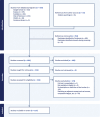Defining Documentation Burden (DocBurden) and Excessive DocBurden for All Health Professionals: A Scoping Review
- PMID: 39137903
- PMCID: PMC11524753
- DOI: 10.1055/a-2385-1654
Defining Documentation Burden (DocBurden) and Excessive DocBurden for All Health Professionals: A Scoping Review
Abstract
Objectives: Efforts to reduce documentation burden (DocBurden) for all health professionals (HP) are aligned with national initiatives to improve clinician wellness and patient safety. Yet DocBurden has not been precisely defined, limiting national conversations and rigorous, reproducible, and meaningful measures. Increasing attention to DocBurden motivated this work to establish a standard definition of DocBurden, with the emergence of excessive DocBurden as a term.
Methods: We conducted a scoping review of DocBurden definitions and descriptions, searching six databases for scholarly, peer-reviewed, and gray literature sources, using the Preferred Reporting Items for Systematic Reviews and Meta-Analyses Extensions for Scoping Review guidance. For the concept clarification phase of work, we used the American Nursing Informatics Association's Six Domains of Burden Framework.
Results: A total of 153 articles were included based on a priori criteria. Most articles described a focus on DocBurden, but only 18% (n = 28) provided a definition. We define excessive DocBurden as the stress and unnecessarily heavy work an HP or health care team experiences when usability of documentation systems and documentation activities (i.e., generation, review, analysis, and synthesis of patient data) are not aligned in support of care delivery. A negative connotation was attached to burden without a neutral state in included sources, which does not align with dictionary definitions of burden.
Conclusion: Existing literature does not distinguish between a baseline or required task load to conduct patient care resulting from usability issues (DocBurden), and the unnecessarily heavy tasks and requirements that contribute to excessive DocBurden. Our definition of excessive DocBurden explicitly acknowledges this distinction, to support development of meaningful measures for understanding and intervening on excessive DocBurden locally, nationally, and internationally.
The Author(s). This is an open access article published by Thieme under the terms of the Creative Commons Attribution-NonDerivative-NonCommercial License, permitting copying and reproduction so long as the original work is given appropriate credit. Contents may not be used for commercial purposes, or adapted, remixed, transformed or built upon. (https://creativecommons.org/licenses/by-nc-nd/4.0/).
Conflict of interest statement
A.J.M. reports employment by JP Morgan Chase, with a role at the financial institution unrelated to her capacities associated with this research, and this work was performed on her own time. K.C. reports grant funding from National Institute of Nursing Research (NINR) and American Nursing Foundation, and a leadership role for AMIA (Board Member). J.J.C. reports professional duties at the University of Alabama at Birmingham. D.E.D. reports leadership roles on the Corporation for Corporation for National Research Initiatives (Board Member) and the International Academy for Health Sciences Informatics (Board Member). C.D. reports receiving training funding from National Library of Medicine T15 Training grant. K.J. reports grants from FDA Sentinel Program, NIH Pioneer Award, support for attending NIH and Robert Wood Johnson Foundation meetings, and leadership roles for American College of Medical Informatics (President), ex officio member of AMIA Board of Directors, and Robert Wood Johnson Foundation (Chair of National Advisory Committee for Amos Medical Faculty Development Program). J.A.M. reports serving on scientific advisory board for and holding shares in Augmedix. R.G.M. reports funding from the American Medical Association. S.C.R. reports grant funding from Agency for Healthcare Research and Quality, NINR, and a leadership role for AMIA (Chair of AMIA's 25 × 5 Task Force). V.T. reports a leadership role for AMIA (Board Member).
Figures




References
-
- McDonald C J, Callaghan F M, Weissman A, Goodwin R M, Mundkur M, Kuhn T. Use of internist's free time by ambulatory care electronic medical record systems. JAMA Intern Med. 2014;174(11):1860–1863. - PubMed
-
- Sinsky C, Colligan L, Li L et al.Allocation of physician time in ambulatory practice: a time and motion study in 4 specialties. Ann Intern Med. 2016;165(11):753–760. - PubMed
Publication types
MeSH terms
Grants and funding
LinkOut - more resources
Full Text Sources
Research Materials
Miscellaneous

